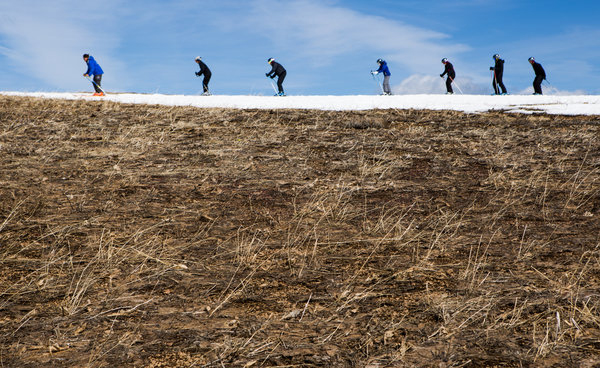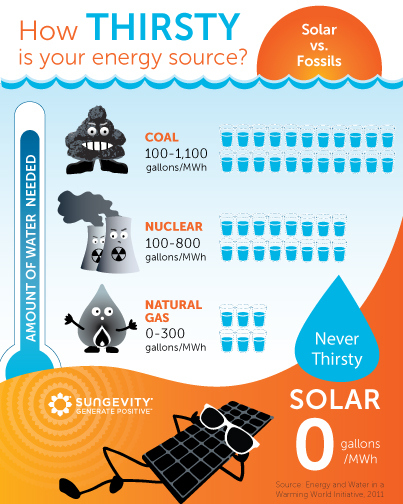
Skiers avoid dry patches at Squaw Valley Ski Resort. Photo: Max Whittaker/Getty Images/New York Times via Sungevity, 2015
This article originally appeared on the blog of Sungevity, a Diamond Certified company.
Guest post by Leslye Penticoff
In April, California’s Governor Jerry Brown imposed mandatory restrictions on the state’s water use for the first time in history. The announcement coincides with the end of another disappointing winter season for local skiers, who looked on enviously as snowfall set records in New England. The evidence is clear: the drought in California is serious, and it’s getting worse. So, why is solar energy making us hopeful? Because solar energy requires little to no water to generate electricity, unlike other energy sources, and it’s growing like gangbusters across California.
Governor Brown clearly didn’t come to his decision lightly. The California Department of Water Resources released data last month showing that the snowpack in the Sierra Nevada range has reached historic lows, containing only19% the amount of water as is normal for March. The Sierra Nevada snowpack serves as a vital storage mechanism for water in the state: melting snow from the Sierras usually supplies 30% of California’s water during spring and summer months. Unless California sees huge snowstorms in the next two months, 2015 will be the state’s fourth consecutive year of drought.
Can we expect this drought to end soon? It’s looking unlikely. National Geographic reported last year that multi-year dry spells like this might be the norm for California – the previous 100 years were just unusually wet for the state. And according to a new study, climate change is only going to make things worse. Dr. Noah Diffenbaugh and his research team from Stanford University recently published data that shows a strong link between California’s drought conditions and human-caused climate change.
This is how the future of California’s drought becomes tied to solar energy. When it comes to solar, California leads the nation with more solar energy installed than any other U.S. state: 8,544 MW to be exact, or enough to power nearly 2 million homes. And solar is being installed at an exponential rate, so the story doesn’t end there. Solar’s success story in California is directly helping the state reduce carbon emissions and address climate change head on.
Moreover, solar is one of the least thirsty energy sources around. As we published last year, coal-fired power plants require 100-1,100 gallons of water to generate one megawatt-hour (MWh) of electricity. Nuclear isn’t much better, requiring 100-800 gallons. Solar, by comparison, requires as little as zero gallons of water to produce the same amount of electricity.
Solar energy will not solve the drought in California by itself. Stakeholders across the state are tackling the problem from all sides, from reforming groundwater management regulations to constructing smart irrigation systems that use wireless sensors to measure precisely how much water a plant needs. When in drought, every drop of effort makes a difference.

